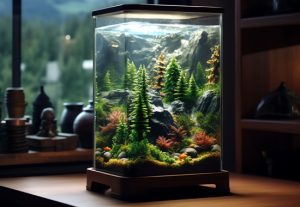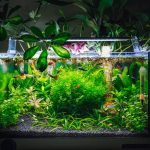Aquascaping is the arrangement of aquatic plants, rocks, stones, cave work, or driftwood within an aquarium to create an underwater landscape (natural scenery such as mountains, valleys, or beaches).
It is also referred to as gardening underwater. Aquascapes are underground environments designed for aquariums. Aquascaping designs include several styles, like Dutch, Jungle, Iwagumi, and Nature aquascapes.
The Dutch style of aquascaping:
 Dutch-style aquarium decoration[/caption]
Dutch-style aquarium decoration[/caption]The Dutch style of aquascape focuses mainly on the growth and arrangement of aquatic plants of different sizes, colors, shapes, and textures in an aquarium. It is a plant-only setup with little to no hardscape, such as driftwood or rocks. 90 & of the aquarium bed contains plants.
A style of the 1930s:
It is considered the oldest aquascaping style, introduced in 1930 in the Netherlands when the Dutch Society of Aquarists (NBT) published the guidelines regarding Dutch aquascape.
Grouped arrangement of plants:
It is a specific aquascaping style characterized by dense plant growth and emphasizes plant cultivation in groups rather than grown separately all over the aquarium.
Focal point with red plants:
The focal points in an aquarium are the spots that draw the eyes. In Dutch style, two to three red plants are grown as the focal point to display the plant's color contrast.
What is Terracing?
Terracing is a landscape technique that forms terraces or steps on uneven or sloping land. It includes cutting into the slope or hill and making a series of leveled areas, like a terrace or step. While withholding walls hold and keep steps or terraces in their place.
Terracing in Dutch Aquascape:
Terracing promotes the visual appeal of a landscape in Dutch aquariums. It helps in arranging aquatic plants in distinct layers. Terracing allows layers of plants to receive good light and nutrients to grow better. Fish and invertebrates enjoy hiding in terraced spots. The plant's layers prevent excessive light exposure to the water column, which helps to control algae. Plants on higher terraces are closer to the light source and receive more light. Lower terrace plants are in the shade due to the blockage of light by high terrace plants, which is appropriate for plant species that need low to medium light.
Steps to Achieve Terracing in Dutch Aquascape Aquariums:
- The sloped or layered substrate creates different levels. Towards the back, it is thicker and shallower at the front.
- Plants with different heights and sizes can make terraced effects. Taller plants at the front and shorter ones at the back, in a way that they gradually rise from one level to another, building a stepped appearance.
- Careful Insertion of plants into the substrate to approach the desired terraced structure. When the plants grow, they may need trimming to achieve the proper level and prevent them from overcrowding smaller plants.
Main Elements of Dutch Aquascaping:
Aquatic plant
1. Dutch aquascaping uses aquatic plants with different leaves, shapes, colors, and sizes. Plants are required to be arranged in a way that appears aesthetically pleasing.
2. Balanced use of plants
Symmetry or balance in Dutch aquascape offers the balanced use of plants. The design includes techniques like the street style or terracing style.
3. Colorfulness
The colorful plantation is a motive of Dutch aquariums. To make the aquascape stunning, red, green, and pink aquatic plants are grown. Lightning, nutrients, pruning, and maintenance are required to ensure plants achieve their vibrant shape.
4.Maintenance
Dutch aquascape needs proper care and attention to ensure the plant's growth. Plant trimming and supplementation are required to attain the desired shape and vibrancy. Liquid and root supplements are essential for healthy plant growth.
5. Least hardscape
Unlike other aquascape styles that use driftwood or rocks, Dutch aquascaping focus on using aquatic plants. However, minimal use of hardscape maybe depends on one's preference.
CO2 and Lighting:
CO2 injection and plant fertilizers are highly preferred to promote fast
plant growth. Standard 75 fluorescent tubes or LED lights are suitable for Dutch aquascaping.
Plants for Dutch Aquascaping:
The Foreground plants
These plants are present at the front of an aquarium. These are low-growing carpeting plants that create a lush green carpet effect.
Common Fore ground plants include
- Dwarf baby tears
- Dwarf hair grass
- Marsileas hirsute
Midground plants
Midground plants are slightly higher than carpeting plants and are the focal points in an aquarium. They attract due to their color, size, and unique texture.
Common Midgrounds plants include
- Rotala rotundifolia
- Alternanthera reineckii
- Staurogyne repens
- Ludwigia arcuata
Background plants
Background plants are present behind the midground plants. These plants are usually taller than the foreground and midground plants. The background creates a dense green effect and helps to highlight foreground and Midground plants.
Background plants include
- Vallisneria spiralis.
- Sword plants
- Cryptocoryne species
- Ludwigia species
Final words:
Dutch aquascaping is all about creating a captivating aquatic world in an aquarium. Patience and time are the keys to achieving healthy, thriving plant growth. The aquascapers need to have a good understanding of aquatic plants, how to grow them, and combine them into groups to create this attractive aquascaping style.
Categories: Aquascaping, Tags: Aquarium, Aquarium decoration, Aquarium setup,




